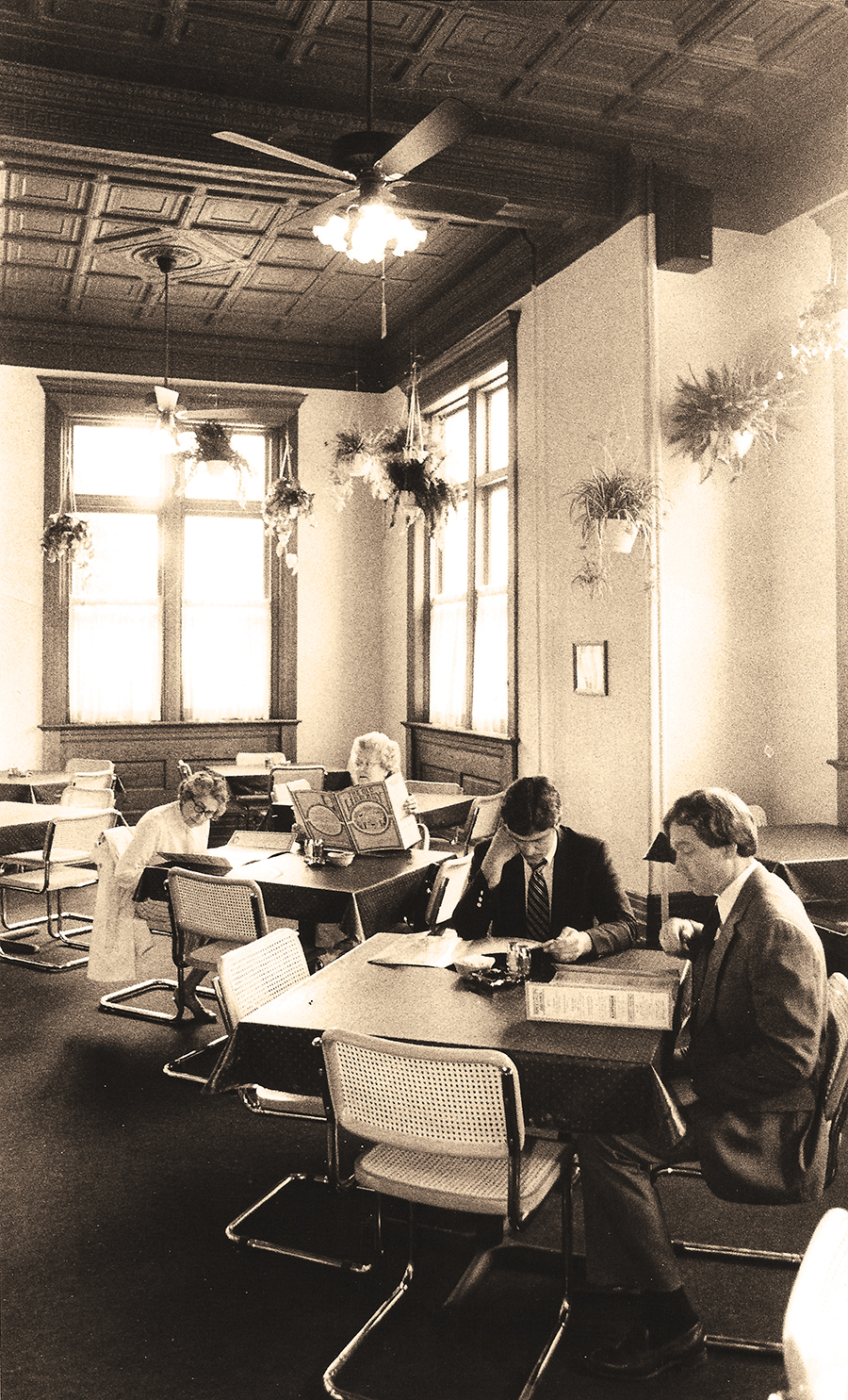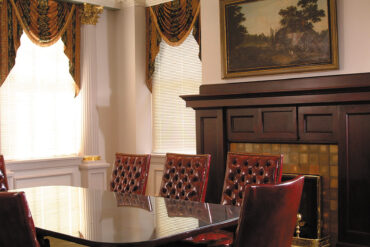In part two of our series, we take another quick trip down memory lane to remember 10 restaurants that people from Huntington once called their favorites.
By James E. Casto
HQ 74 | SUMMER 2011
In our Spring issue, we took a stroll down memory lane and recalled some of Huntington’s favorite former eateries. But no single article would be adequate to capture all the memories of meals gone by at the city’s many wonderful restaurants of yesteryear, so here’s a generous second helping of restaurant memories.
CALAMITY CAFE

For more than a decade, the Calamity Café on the corner of Third Avenue and Hal Greer Boulevard was a favorite among many Marshall University students, faculty and other loyal customers who looked on it as more than just another eatery.
The colorful café not only served up delicious Southwest-flavored food, it also provided an outlet for local musicians, artists and poets to showcase their talents. Over the years the restaurant hosted all manner of happenings – weddings, coming-home and going-away parties, birthday parties, baby showers, even funeral receptions – and the freewheeling “Open Mic” nights at the cafe became the stuff of local legend.
Operated by a husband-and-wife team, Terre Thomas and Roy Clark, Calamity Café opened in 1992 and closed in 2005.
FRANK’S SANDWICH SHOP

The late Frank Volk served lots of different sandwiches at the little shop that bore his name. But a clear favorite with many of his customers was his “steak sandwich with hots.”
One of the sandwich’s biggest fans was Huntington Quarterly columnist Clint McElroy who recalls practically living on a diet of them during his days as a Marshall student. Today, years later, he can still describe them in mouth-watering detail.
“The steak was sliced thin, and seasoned in some way that I’m sure is a closely guarded secret,” says McElroy. “To this day, I’m not sure what ‘hots’ really were. They had the appearance of finely-chopped peppers, but what kind? Pasilla Chile? Poblano? Turkish Cayenne? And what did they add to the peppers? Nothing that small could pack that much heat!”
McElroy still mourns the September he came back to town from summer vacation and found that Frank’s had closed its doors. Today the corner site where it stood is home to Graley Autobody’s drive-in claim center.
Master sandwich-maker Frank Volk died in 2010, but the legend of his steak sandwich lives on.
MICHAEL’S

Interviewed by The Herald-Dispatch shortly after the 1980 opening of Michael’s, his fancy new restaurant, chef Michael Bunting described it as a place for people “who take a meal seriously.”
“People come to enjoy the food for the food’s sake,” Bunting said, adding that it wasn’t unusual for diners to linger for hours over their meal.
Michael’s was located at 1045 Fourth Ave., in a building that once housed the J.L. Cook Hardware Co. An extensive remodeling erased any trace of the former hardware store.
The menu featured French-American cuisine, including such specialties as flaming entrées and desserts prepared tableside. At a time when many other restaurants were offering band music, Michael’s opted instead for a pianist who performed light classical pieces each evening.
Bunting attended the Culinary Institute of America at Hyde Park, N.Y., and was executive chef at Guyan Country Club before opening his restaurant.
Though it’s long gone, Bunting’s restaurant is well remembered by many who dined there. After it closed, Glenn’s Sporting Goods and radio station The Dawg, located in the Coal Exchange Building next door, expanded into the restaurant’s former space.
THE OLD LIBRARY

When the Cabell County Public Library moved out of its long-time location at Fifth Avenue and Ninth Street and into a modern new building built just across the Ninth Street Plaza, the fate of its old building was at first uncertain.
Enter a group of investors from Columbus, Ohio, who saw a bright future for the former library, a handsome structure in 1904 with a grant from steel tycoon and philanthropist Andrew Carnegie. Their idea? Transform the building into a restaurant.
Thus was born The Old Library restaurant, which opened in April 1982. The restaurant still looked much like a library, with books and shelves here and there. With seating for 180 customers, it included a bar, lounge area and game room. The bar was constructed as a square island in the middle of the main floor. Above the sofas in the lounge area was a mezzanine with tables and chairs.
The lunch menu featured subs and other sandwiches, salads and pizza. The dinner menu included steak and seafood.
Initially, the restaurant attracted its fair share of customers, but ultimately it proved unsuccessful and was forced to close its doors. Since 1985, the building has been the home of Huntington Junior College.
OLIVER’S

Dan Shoemaker credits a trip to London as the inspiration for the name and theme of Oliver’s, the downtown Huntington restaurant he and his partners opened in 1991.
“My wife and I went to London and fell in love with everything there,” he recalls. “And I’ve always been a big Charles Dickens fan, so it just all came together.”
The ground floor of the parking garage at Fourth Avenue and 10th Street previously had housed a furniture store and, before that, a five-and-dime store. An extensive renovation transformed it into a modernized version of an old English pub.
Ads promised the restaurant’s visitors they were in for “A Dickens of a Good Time.”
The idea, Shoemaker says, was to create an attractive place where customers could grab a quick lunch, a few after-work drinks or a nice dinner.
“Not long after we opened, we were the highest-grossing restaurant in the Huntington area,” he says.
After a few years, Shoemaker sold out to his partners. The restaurant closed in 2001. Since then, the spot under the parking garage has seen a series of restaurants come and go, none staying very long.
THE PEANUT SHOPPE

Originally opened as a franchise location by the Planters Peanut Co. in 1924, The Peanut Shoppe was a downtown Huntington institution for more than 80 years. Located at 941 Fourth Ave., the shop was ideally situated for the many movie fans who would stop in on their way to or from the theater.
When Planters decided to exit the retail business, the shop became locally owned and over the years was owned and operated by a series of families. Doug and Donna Myers bought the shop in 2000 and ran it for nine years. They continued the traditional dry-roasting of peanuts and added a number of new offerings, such as party trays and gift tins with the logos of area sports teams.
In 2006, when the nearby Keith-Albee stopped operating as a movie theater, The Peanut Shoppe lost many of its best customers. In 2008, the Myers family sold the shop so they could concentrate on a new business venture, the Pita Pit restaurant. The new Peanut Shoppe owner was unable to make a go of the shop, which is now closed. A “For Lease” sign can be seen in one of the front windows.
Today, brothers Nathan and Stetson Myers operate the Pita Pit – reflecting a bit of the entrepreneurial spirit that was sparked in them as children when their parents let them keep the proceeds from a gumball machine at The Peanut Shoppe.
PERMONS

Permons restaurant was only open for five years, but many of those who dined there recall those as grand years. Everything about the restaurant bespoke class and elegance.
The 15-story West Virginia Building on the corner of Huntington’s Fourth Avenue and Ninth Street was an impressive structure when it was built in 1924, but years of neglect had taken a toll by the time Huey Perry and his partners bought it in 1981. Perry immediately began refurbishing the dilapidated building and, as part of that effort, decided to install a first-class restaurant on the top floor.
The Permons name was based on the names of the building’s owners – Huey Perry, his brother Mervil and Jeff Monroe. The three partners spent a reported $700,000 designing, building and furnishing their restaurant.
Perched high above downtown Huntington, Permons offered spectacular views. A projecting covered terrace was built on the river side of the building, giving diners seated there the feeling of floating in mid-air. The restaurant’s tables were set with custom-designed plates, hand-blown West Virginia glassware and other elegant touches. The extensive menu offered only the finest in food and drink.
“It was an extraordinary restaurant,” Huey Perry recalls. “We unfortunately got caught up in a recession and were only able to keep it alive five years.”
SNAKS FIFTH AVENUE

In 1980, the Harrison family, who had created the popular Heritage Station restaurant at Heritage Village, opened a second eatery – Snaks Fifth Avenue, located on the lower level of the Fifth Avenue Hotel at 901 Fifth Ave.
Antiques, polished woodwork, cut glass, oriental rugs and hanging plants gave the restaurant a Victorian “shabby chic” appearance. The menu offered soup and sandwiches for lunch and a variety of dinner options, but many customers stuck to the menu’s “snak” section, ordering potato skins, fried zucchini and mushrooms, shrimp, oysters, cheese platters and chicken platters.
Customers entered the basement-level eatery after descending an outside flight of stone steps. At the bottom, the stairway opened up to a patio area, with wrought-iron tables and chairs utilized for outdoor dining during good weather. A wooden door with a stained-glass inset opened to the restaurant.
The entire Harrison clan – brothers Karry and Dirk, parents, spouses – pitched in to operate the restaurant, which flourished for a number of years before it closed.
VICTOR’S

In the late 1930s, Herman Brodof moved to Huntington from Cincinnati and opened a kosher butcher shop on Eighth Street at Seventh Avenue. With the outbreak of World War II, he donned an Army uniform and went off to serve in Europe. When the war was over, he returned home and, with his wife Sophie, opened a delicatessen at 1007 Third Ave.
Flush with patriotic pride, the Brodofs had planned to call their fledging business the Victory Delicatessen. But a sign artist who had one too many beers painted a sign that identified it as Victor’s. And so it remained. There was no money to pay for another sign.
Until the family business closed in 1992, Victor’s was the go-to place for fans of chopped liver, brisket, incredible potato salad and more. It was also a lunch mecca everyone flocked to for the best soup, salad and sandwiches in town. Loyal fans followed the deli wherever it moved.
In 1979, the Brodofs – now joined by son Mark and his wife Suzi – debuted an expansion that doubled the size of their Eighth Street business, providing room for more restaurant seating, more shelves stuffed with exotic food products, a wicker shop, a kitchen shop and a complete working kitchen for gourmet cooking classes.
“Not a day goes by,” says Suzi Brodof, “that somebody doesn’t tell me how much they loved Victor’s.”
WIGGINS BAR-B-Q

Fans of Wiggins Bar-B-Q had two locations to choose from – one on Fifth Avenue across from the former Huntington East High School and the other on the corner of Fourth Avenue and Hal Greer Boulevard, just a few steps from Marshall University’s Old Main. East High and Marshall generated lots of customers for the two restaurants.
The Fifth Avenue restaurant was started, logically enough, by a man named Wiggins. Research has failed to yield the year that Ralph Wiggins opened his eatery, although many folks recall eating there during the World War II years. As the name suggests, barbecue sandwiches were a popular item on the menu, as was the spaghetti. In 1956, a group of local businessmen purchased the restaurant, which continued operating until the mid-1980s.
Meanwhile, Dave Freeman had obtained permission to open a second Wiggins on the Fourth Avenue corner across from Old Main. A former ramshackle drive-in was demolished and a new building built. It opened in 1957 and quickly became a busy place.
Rob Freeman, who later took over operation of his father’s restaurant, recalled that over the years the business increased fivefold.
“At one point, we were doing so many carry-out orders at lunch time that we had to use six delivery people,” he says.
The Freemans sold the restaurant in 1995. The next year, it burned and was not rebuilt. Today, the menu at Tascali’s restaurant on U.S. 60 East includes “29th Street Wiggins Spaghetti,” made from the restaurant’s original chili-flavored recipe.





